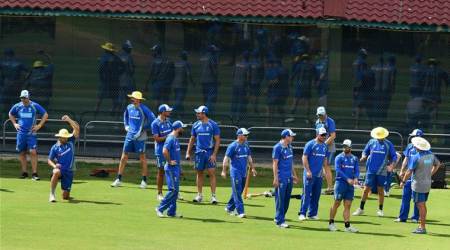 Australia are touring India for five ODIs and three T20Is. (Source: AP)
Australia are touring India for five ODIs and three T20Is. (Source: AP)
The elemental Nathan Lyon pictures are those that faithfully capture his cheery smile, his palm flitting through the stubble. He is also known to gently banter around in the field and playfully engage the batsmen and the umpires. So much so that he is the walking antithesis of the fabled angry Aussie — no mean stares and meaner words. But even he gets short-fused when asked about his continued omission from cricket in coloured clothing. At a press conference, he once fumed at a reporter, and asked him to pose the question (about his sidelining) to the chief selector Rod Marsh, before he stormed out of the room. It’s such a touchy matter that even his teammates desist from the subject.
Marsh’s tenure has long ended, but selectorial mood hasn’t. So Lyon, who recently usurped Richie Benaud and Clarrie Grimmet as Australia’s second-most prolific spinner after Shane Warne in Tests, is discussed as an afterthought, or not even discussed at all, in the context of limited-over matches. Consequently, he has featured in a solitary T20I and 13 ODIs, scattered over five years. And that’s the reason, his absence from the ODI series that starts at Chennai this Sunday, hasn’t come as a surprise.
But his prolonged omission stills hangs innocuously over Australian cricket, not least it confounds former skipper Michael Clarke. “I have always wondered and brought up this question myself a few times as why Nathan is not playing as many limited-over matches, as he should have. Obviously, it’s the selectors’ call, but I can’t help wondering about Nathan, especially when he’s bowling so well in the subcontinent,” he says.
Not just when he’s bowling well, but when Australia is struggling to present a half-reliable spinner in the shorter versions. Since his debut, five years ago, they have frenetically experimented, from blooding in rookies such as Adam Zampa, Fawad Ahmed and Ashton Agar to recalling old hands like Xavier Doherty. None of them—Zampa took only two wickets in as many matches in the Champions Trophy– have even remotely sealed the spot, but the selectors seemed to hell-bent in cotton-wooling Lyon from ODIs and T20s, despite the latter expressing his desire to be the “No 1 bowler in all three formats”. The numbers—17 wickets at 34.82 with an economy rate of 4.93–are not hideous either. But there seems to be a perceptible lack of trust, “and for no reason,” as Clarke puts it.
Maybe, the Australian selectors’ are adamant that they want their best spinner to channelise all his focus and energy on Test cricket. Maybe, with Ashes resuming in a few months’ time, they didn’t want to expend him, as he had shouldered considerable workload this year, even developing calluses on his spinning finger during the India series.
It might also stem from a broader and more genric reason, the contagious fetish for a wrist spinner. There’s, globally, an alacrity for selectors and skippers to encourage wrist spinners, a reason and not a coincidence perhaps, that there are so many of them around. From Imran Tahir, Adil Rashid and Devendra Bishoo to Kuldeep Yadav and Shadab Khan to list a few. It’s like in the early 90s, when there was a fixation with military-medium swing bowlers (and they almost won New Zealand the World Cup). Even India seems to be a little caught up with it, though Ravichandran Ashwin’s absence is no correlation, and he will continue to be India’s first-choice spinner across formats, come the big tournaments.
Wrist-spin obsession
The wrist-spin obsession is valid to a certain extent. For wrist-spinners, perceivably, pose more threat with their ability to turn on any surface, than an offie without the doosra or a flat, restrictive left-arm spinner, who were the fad before the wrist-spin resurgence. They also, as former cricketer VVS Laxman opines, bring an extra dimension. “If you’re bowling on an unresponsive pitch in the middle overs, when the bowlers are unable to extract any purchase of the wicket, the leggies can be banked to do something special. Hence, teams are experimenting with wrist spinners with the World Cup in view. The good ones will be very handy in winning matches in all conditions,” he says.
Good ones. The catch is in these words, specifies Clarke. “The priority should be to give your best spinner the best opportunities. No doubt, Zampa and Agar are talented spinners. But at the moment, Lyon is a more evolved bowler. He has terrific control and the smarts to prosper in any format,” he points out.
His expected absence, and that of Ashwin, who has replaced Lyon in Worcestershire, strip this series off an engrossing corollary. While they are not compared and contrasted as much feverishly as they do Steve Smith and Virat Kohli, not even in the Test series early this year where they were most influential, the numbers they have racked up this year make a compelling parallel.
Since the turn of this year, Ashwin has snared 44 wickets from eight matches. Lyon’s corresponding numbers are 46 from seven matches. Ashwin has 292 sticks, Lyon is 23 behind. The Australian has played 17 matches more than the Indian, but is nearly a year younger. For the next few years, the charts of the foremost spin contemporaries will be read and re-read in relation to each other. In the limited-over versions, though, they are men on different boats—Lyon the outsider and Ashwin the glib-skilled spin galactico—rarely uttered in the same breath.

